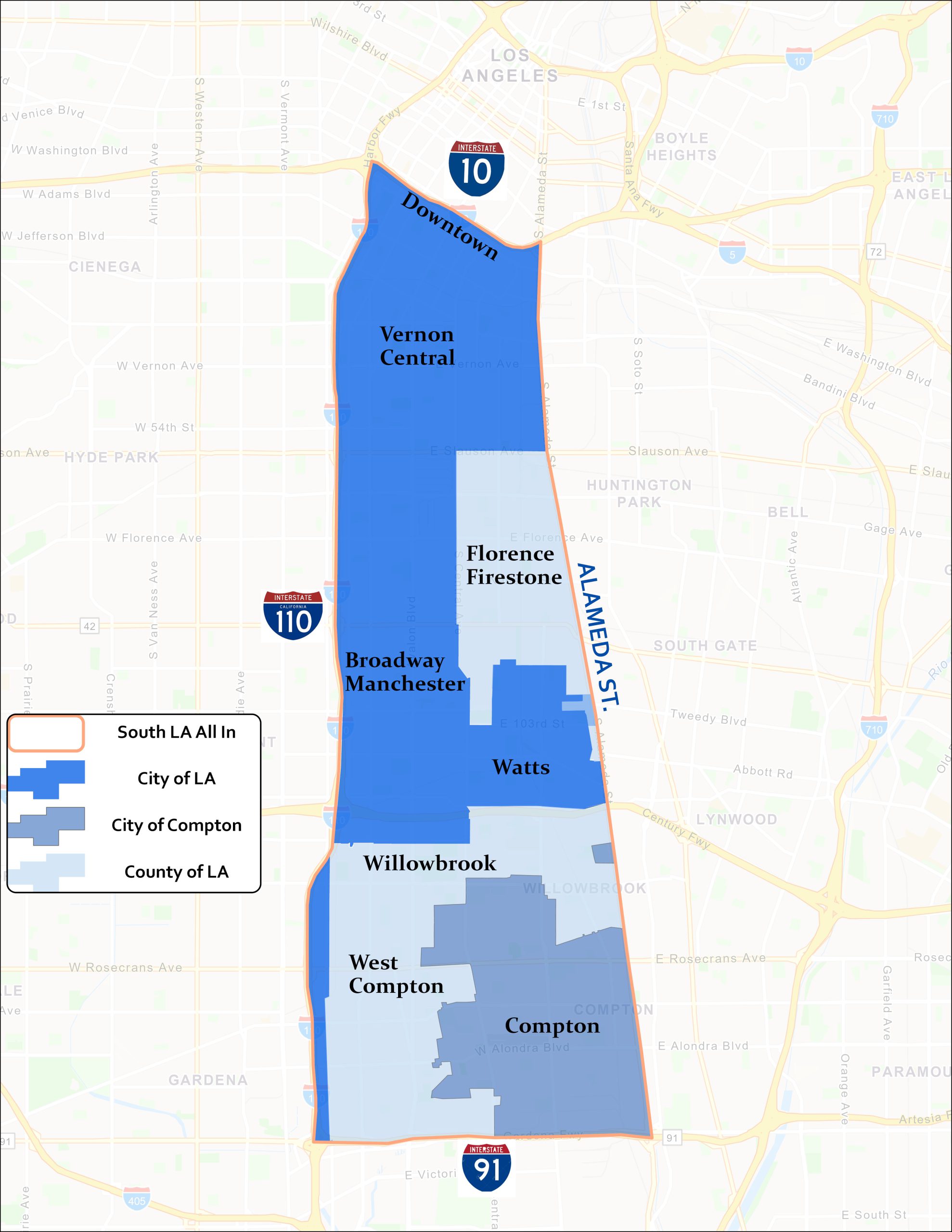Community Development Index
A Project of the South LA All In (SLAAI) Initiative
Created for the Coalition for Responsible Community Development (CRCD)

Launched in late 2023, South LA All In (SLAAI) is a coalition-driven, anti-poverty initiative designed to address longstanding racial and socioeconomic inequities in South Los Angeles.
Anchored by the Coalition for Responsible Community Development (CRCD) in collaboration with a with a diverse cross-sector of public, private and community partners, SLAAI’s mission is twofold:
1. Ensure a just and equitable recovery from the COVID-19 pandemic, recognizing South LA’s unique vulnerabilities and the disproportionate impact of the crisis.
2. Empower residents and local businesses to benefit from the influx of investment and development destined for Los Angeles as we prepare to host the 2028 Olympics.
To learn more and join South LA All In, contact SLAAI@coalitionrcd.org.
As part of this effort, CRCD partnered with NDSC to create the Community Development Index, a user-friendly tool that community stakeholders and leaders could utilize to generate increased investment in South LA and other historically under-served communities.
Click the plus sign (+) below to learn more about the South LA All In Community Development Index.
The NDSC team created the Community Development Index in collaboration with CRCD to identify neighborhoods most in need of investment across each of SLAAI’s priority areas. Three metrics were selected for each priority area based on conversations between the CRCD and USC team as well as current data availability:
Housing Stability & Affordability: (1) Rate of Homelessness, (2) Overcrowding, (3) Severe Rent Burden
Access to Capital: (1) Mortgage Approval Rate, (2) Average Small Business Loan Amount, (3) Homeownership
Good Jobs: (1) Unemployment Rate, (2) Jobs per Worker, (3) Median Earnings per Worker
Education: (1) Postsecondary Graduation, (2) Opportunity Youth, (3) College Enrollment
These metrics were combined to create a score ranging from 1-10 rating the level of community development in each neighborhood in LA County. For each neighborhood, a score ranging from 1-10 is available for the Community Development Index as a whole and for each of the four focus areas.
Click the plus sign (+) below for tips on navigating this page.
Section 1: explore Community Development Index scores for LA County neighborhoods, Service Planning Areas (SPAs) and LA City Council Districts
Section 2: dive deeper and explore the sub-scores for each of SLAAI’s priority areas in LA County neighborhoods
Section 3: learn about the metrics included in each of the priority areas and the methodology used to create the index
See the index score (ranging from 1 – 10) for your neighborhood by hovering over it on a map OR using the menu on the right of each map to add it to the neighborhood comparison chart.
Community Development Index
The South LA All In Initiative area scores a 1 (out of 10) on the Community Development Index, one fifth lower than the LA County average of 5, illustrating a need for increased investment across all of SLAAI’s priority areas.
South LA All In Priority Areas
- The SLAAI area as a whole scored a 1 (out of 10) in the Housing Stability & Affordability category compared to the Los Angeles County average score of 5. See the metrics used in this category compared for the SLAAI area and LA County in the table below:

Variation Across SLAAI Neighborhoods
Investment in housing stability and affordability is critical across all parts of the SLAAI area, where every neighborhood scored a 1 in the housing category except Compton & Watts, which had a score of 2.
- Overcrowding is highest in Florence-Firestone and Historic South Central, where over 30% of households had more than one person per room of their home.
- Severe Rent Burden is highest in Broadway–Manchester & Willowbrook, where over 40% of renters are paying more than half of their income on rent and utilities.
- Homelessness is highest by far in West Compton, where there are more than 676 unhoused residents per 10,000 housed people.
The SLAAI area as a whole scored a 2 (out of 10) in the Access to Capital category compared to the Los Angeles County average of 5. See the metrics used in this category compared for the SLAAI area and LA County in the table below:

Variation Across SLAAI Neighborhoods
Of all the four focus areas, Access to Capital scores varied across SLAAI neighborhoods the most, ranging from 1 to 9. Neighborhoods in the northern part of the area scored lower, while Willowbrook, Compton and West Compton scored considerably higher.
- Homeownership is lowest in Historic South Central (21%) and highest in West Compton (77%).
- Mortgage Approval Rates were lowest in Central Alameda, Historic South Central, and South Park, where there were less than 20 loans approved per 10,000 residents. By contrast, Compton had over 50.
- Average Small Business Loan Amounts were lowest in Watts, Broadway-Manchester and Green Meadows, where small businesses received less than $3500 per employee. Small Businesses in West Compton, by contrast, received over $12,000 per employee.
The SLAAI area a whole scored a 1 (out of 10) in the Good Jobs category compared to the Los Angeles County average of 5. See the metrics used in this category compared for the SLAAI area and LA County in the table below:

Variation Across SLAAI Neighborhoods
Investment in good jobs is particularly critical in the northern part of the SLAAI area. All neighborhoods in the area scored a 2 or lower in the jobs category except Compton and West Compton, which had a score of 3.
- Jobs per worker is lowest in Broadway-Manchester, Green Meadows, South Park, and Watts, where there are less than 20 jobs per 100 workers.
- Median earnings are less than $30,000 in all SLAAI neighborhoods except West Compton.
- Unemployment is highest in West Compton and Watts, where over 10% of the labor force is unemployed.
The SLAAI area as a whole scored a 1 (out of 10) in the Education category compared to the Los Angeles County average of 5. See the metrics used in this category compared for the SLAAI area and LA County in the table below:

Variation Across SLAAI Neighborhoods
Investment in education is critical across every area within the SLAAI area, where every neighborhood scored 1 (out of 10) except West Compton, which scored a 3.
- Between 30% and 40% of young adults are enrolled in school across all SLAAI neighborhoods except West Compton, where 51% are enrolled.
- Compton & Willowbrook have the largest share of opportunity youth. In those neighborhoods, between 19 and 20% of young people ages 16 to 24 were neither working nor in school.
- Less than 20% of adults have an Associate’s Degree or higher level of education across every SLAAI neighborhood.
Metrics & Methods
Click the link below to download a short brief of the methodology used to develop the index along with the definitions and sources of all metrics used.



